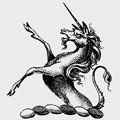Strickland Family Crests. Which Strickland is your family?
You searched for 'Strickland', but there are 13 families with that name in our historic records. Do you know where your family came from, recognise the name of an ancestor or see your crest? If so, please click on your family from the list below..
SELECT YOUR CREST TO SEE AVAILABLE SILVER
AND REGISTER FOR SALE ALERTS
-
 Hornyold-Strickland
Hornyold-Strickland
Henry Hornyold-Strickland FSA of Sizergh Castle, Westmoreland,…
"Sans mal"
"Fidem tene"
Select
-
 Hornyold-Strickland
Hornyold-Strickland
Henry Hornyold-Strickland FSA of Sizergh Castle, Westmoreland,…
"Sans mal"
"Fidem tene"
Select
-
 Strickland
Strickland
"Sans mal"
Select
-
 Strickland
Strickland
Thornton Bridge, Yorkshire
Select
-
 Strickland
Strickland
Dorchester
Select
-
 Strickland
Strickland
Select
-
 Strickland
Strickland
Sir Charles William, Baronet, J.P., D. L., of Boynton,…
"A la volonté de Dieu"
Select
-
 Strickland
Strickland
Walter Cecil, Esquire, of the Rise, Dawlish, Devon
"A la volonté de Dieu"
Select
-
 Strickland
Strickland
Algernon Augustine de Lille, Apperley Court, Tewkesbury
Select
-
 Strickland-Constable
Strickland-Constable
Henry, Esquire, of Wassand Hall, Hull:
Select
-
 Strickland-Constable
Strickland-Constable
Henry, of Wassand, Yorkshire
Select
-
 Strickland-Constable
Strickland-Constable
Henry, of Wassand, Yorkshire
Select
-
 Strickland-Constable
Strickland-Constable
Henry, Esquire, of Wassand Hall, Hull:
Select
Strickland
There are two main families by the name of Strickland.
The first is the ancient and distinguished anglo catholic family of Strickland have been established with extensive estates in Westmorland and Cumberland since at least 1179, building Sizergh Castle as their base in 1343. Heavily involved in the wars with both Scotland and France the family distinguished itself over many centuries until the reformation. Their status as prominent recusants over the succeeding centuries largely excluded them from the court, politics and offices of state and explains why such an old and distinguished family were not granted a peerage until the earl 20th century.
The second is that of the Strickland-Constable baronets.
Although the Stickland-Constable baronets are descended from x Strickland of x yorkshire it is unclear as to whether they are descended from a cadet branch of the Stricklands of Sizergh.
Burkes Landed Gentry notes that in the Domesday book the lands of Castlecarrock, Cumberland were held by Gilmichael subsequently passing to the de Vallibus family. In 1179 they were held by Adam de Castlecarrock and his younger son, Sir Walter de Stirkeland (circa 1151-1239) of the manor of Stirkland took part in the Baron's rebellion of 1215 which resulted in the signing of the Magna Carta. He married Christina de Leteham and is recorded to have had a licence for a domestic chapel at his manor at great Strickland in 1230 and was a Justice of Assize at Appleby in 1228 and 1236.
He was succeeded by Adam de Stirkeland, who was in turn succeeded by his nephew, Sir Robert de Stirkeland, coroner for Cumberland who died in 1278. His eldest son, Sir William de Stirkeland, 1219-1305 was granted the manor of Great Strickland by his father in 1239 and married Elizabeth Deincourt, daughter of Sir Ralph Deincourt of Sizergh (which had been granted to the Deincourts by Henry II between 1170-1180) and eventual heiress to her brother. Sir Walter represented Westmorland in the first separate House of Commons to meet at Westminster in 1290 and left several sons.
His eldest surviving son, Sir Walter de Stirkeland (1255-1343), K.B. (1303), Sheriff of Westmorland (1332) was present at the seige of Caerlaverock (1303) and was in turn succeeded by Sir Thomas de Stirkeland (1290-1376) who built the main tower at Sizergh that stands today.
The history of lengevity in the family was extremely unusual for the time.


This is work in progress.
Any comments please to [email protected]
SNBM